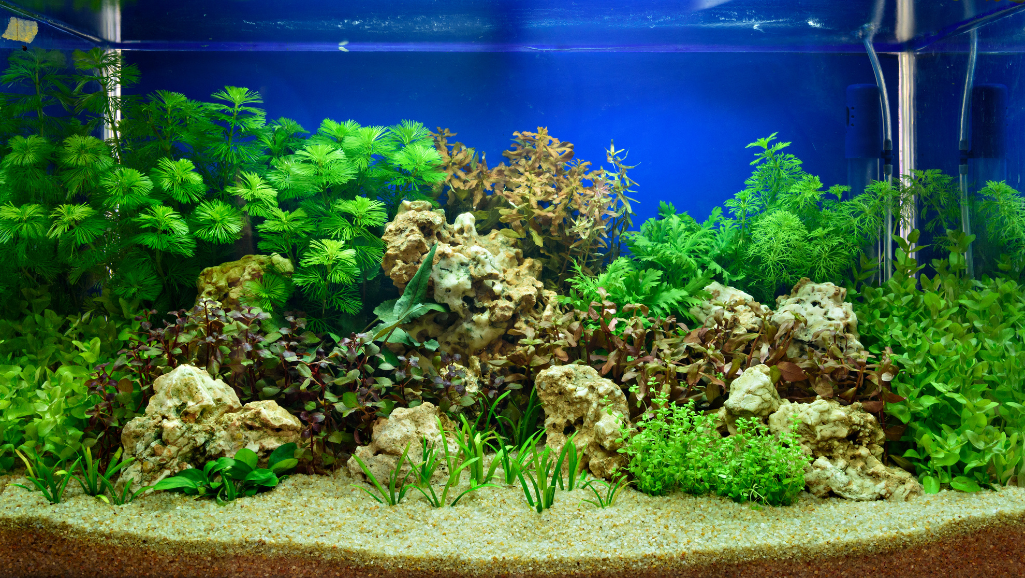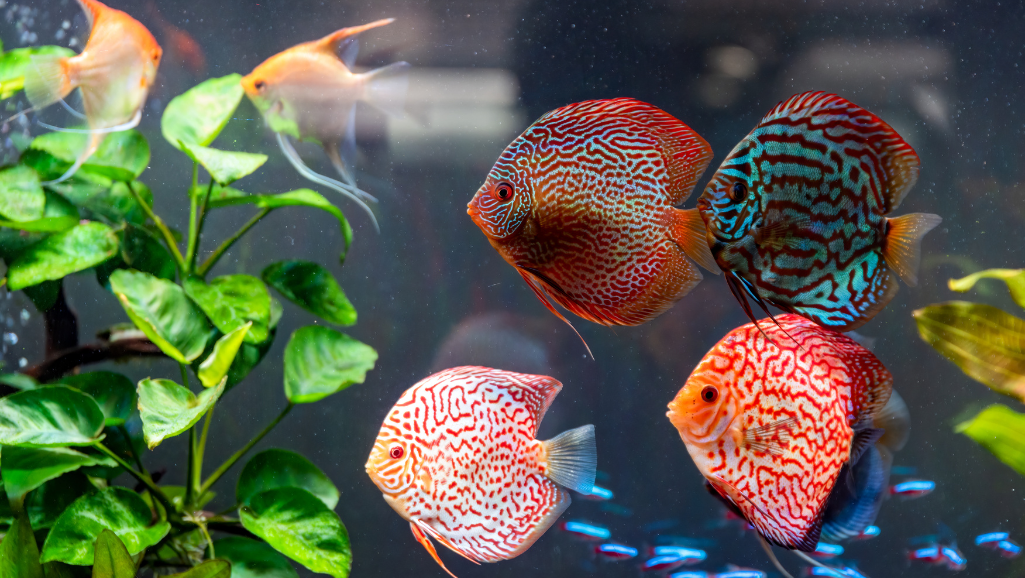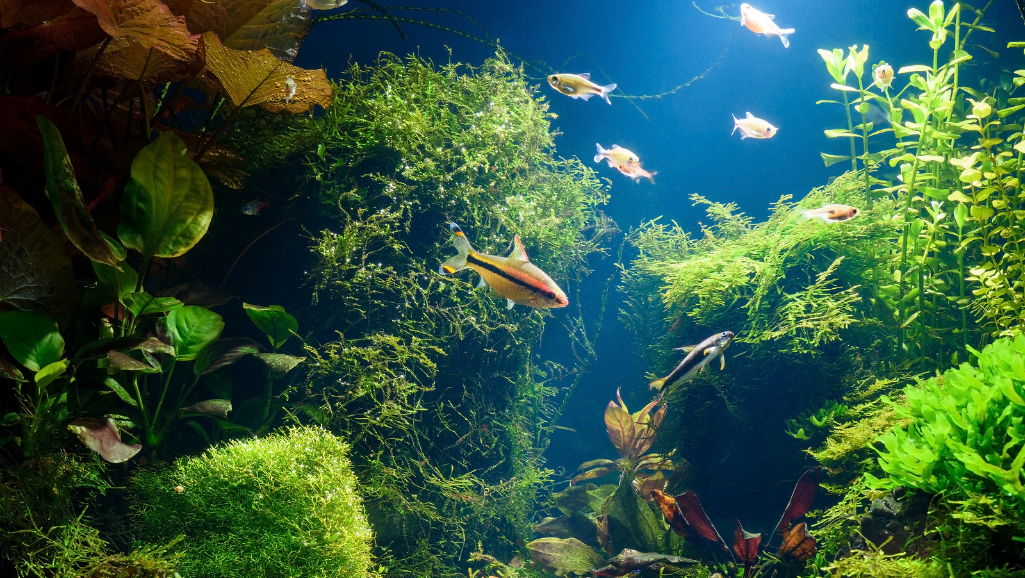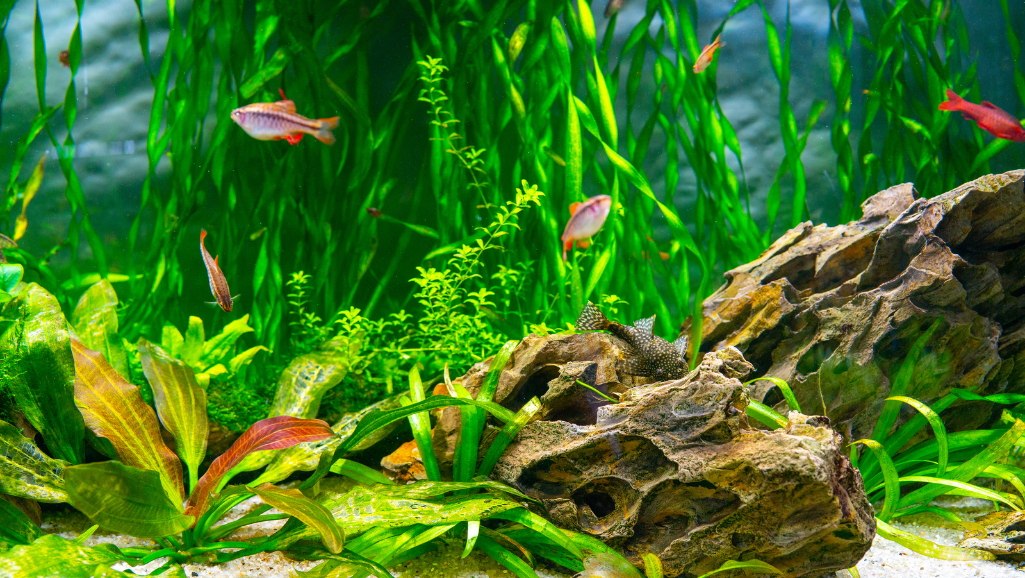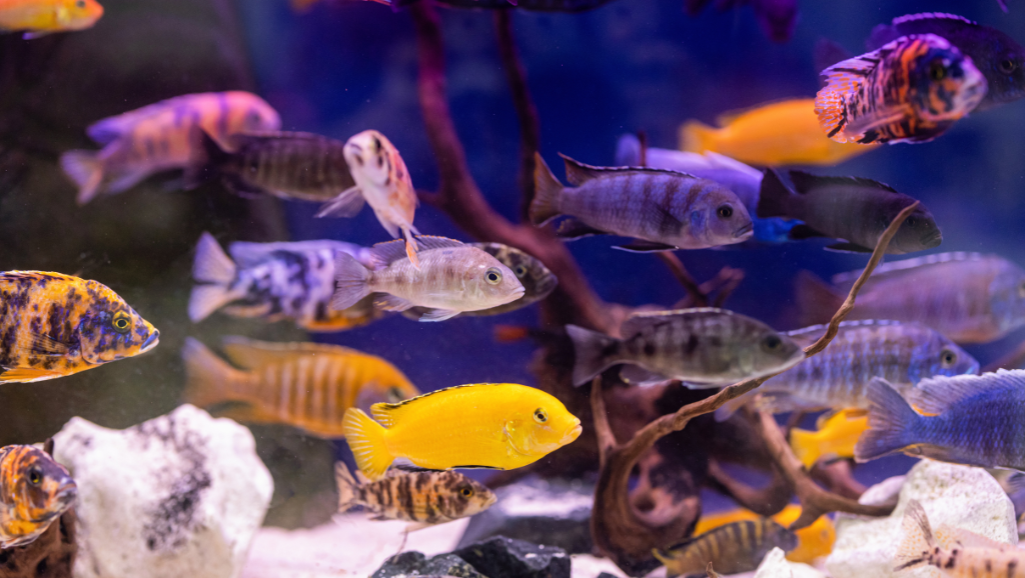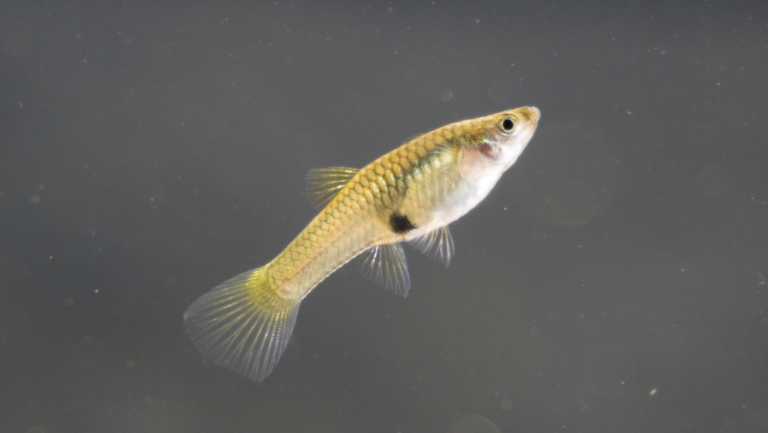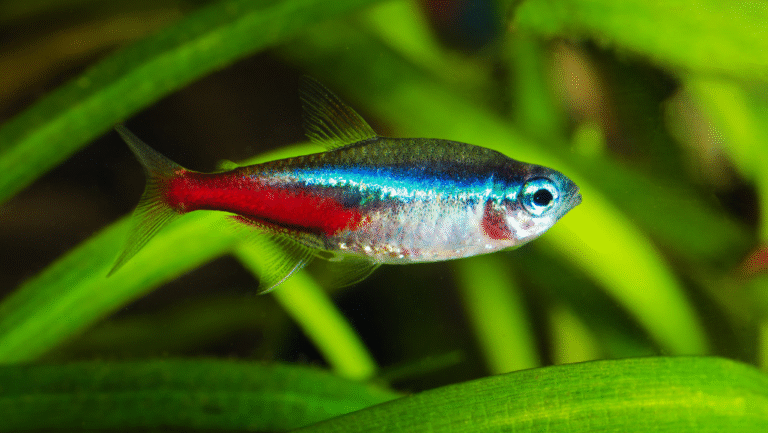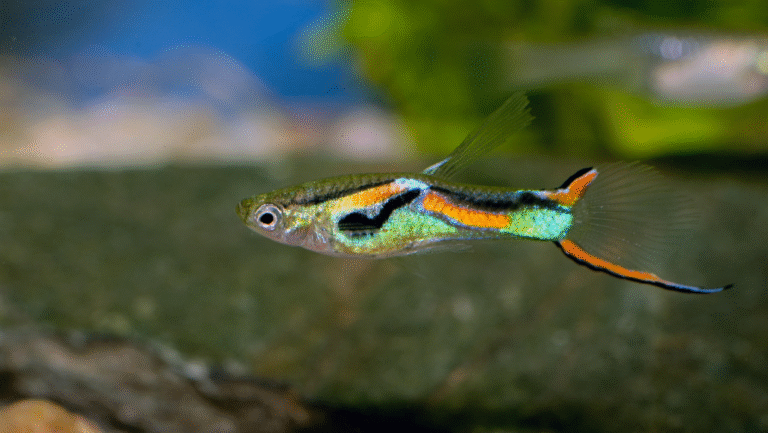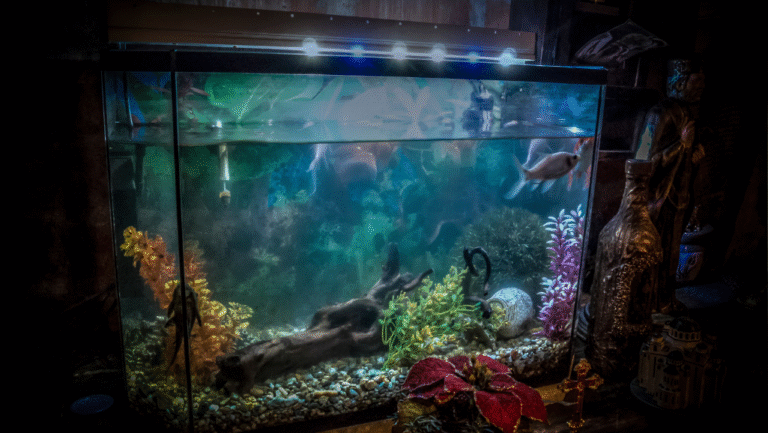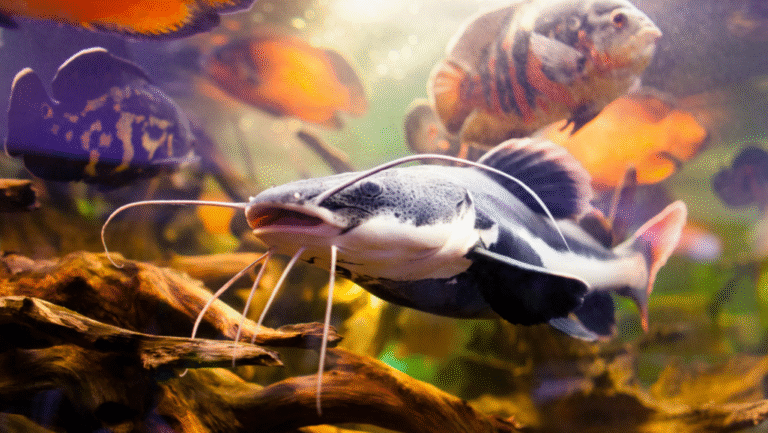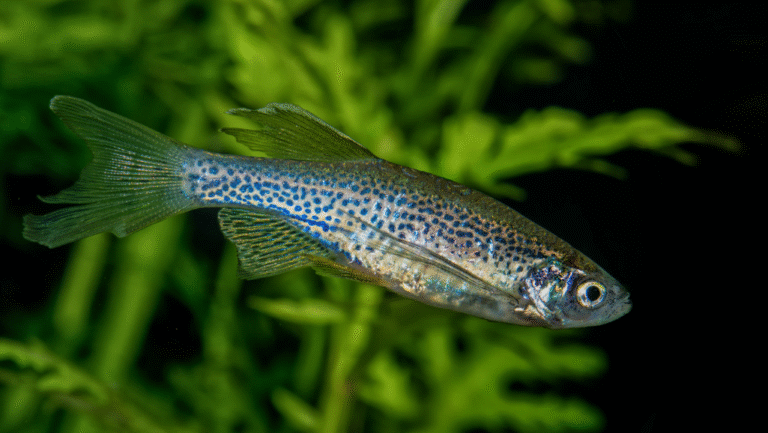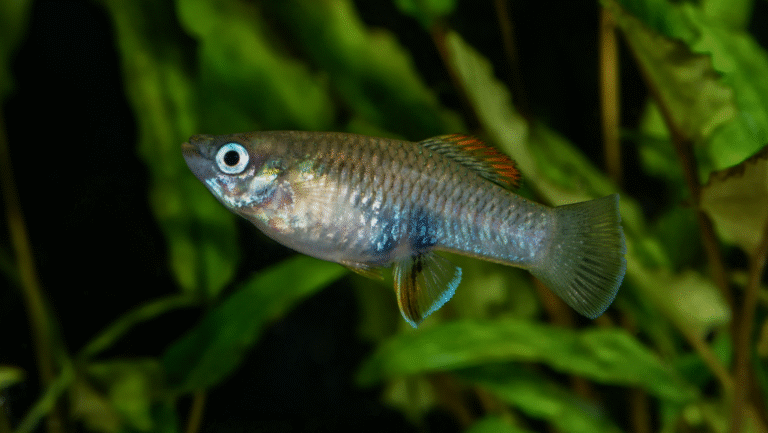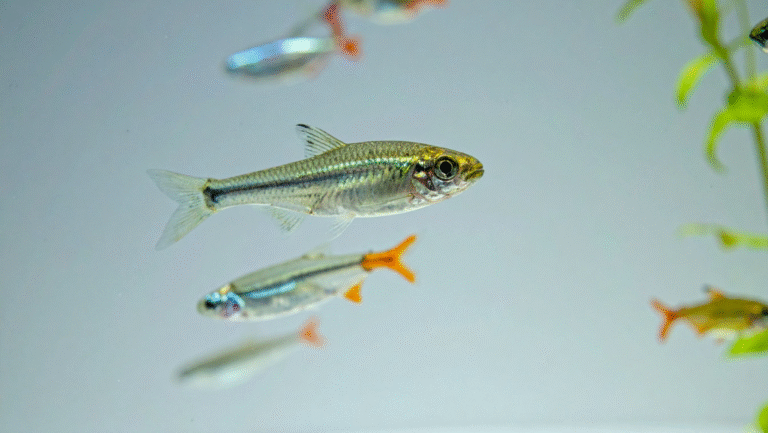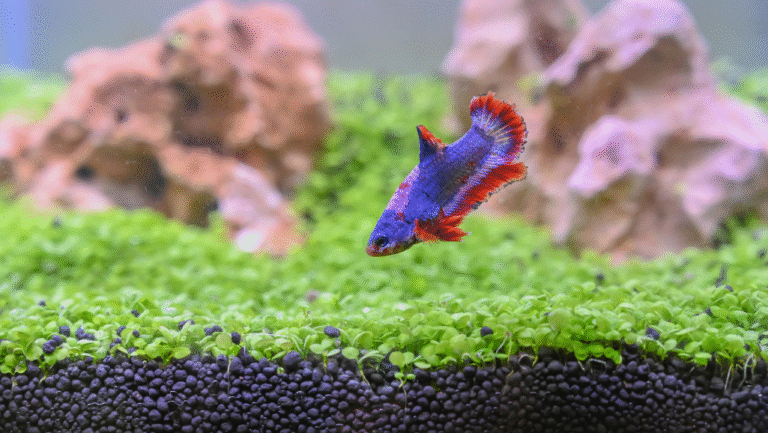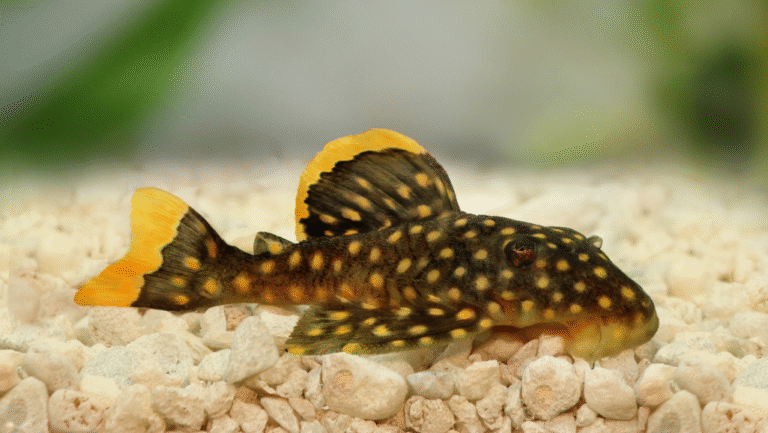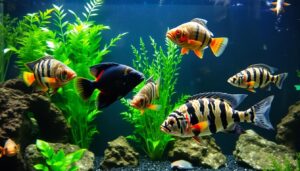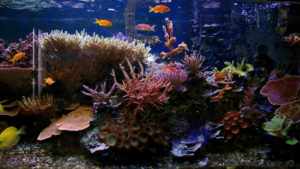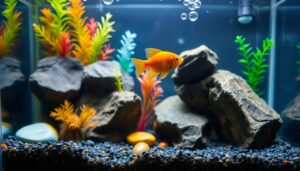Welcome to a curated journey through the Best Fish for Planted Aquariums — practical choices that make your planted tank glow with color and natural movement. This guide highlights species that complement living layouts, so fish and plants work together to create a balanced, beautiful aquarium.
Plants polish water quality by taking up nitrate and competing with algae, which lowers maintenance and helps fish show natural behavior. Densely planted setups can support more stock when filtration and surface flow are appropriate; add new animals gradually and test ammonia and nitrates a day after stocking to catch spikes early.
Keep surface flow steady so leaves stay healthy, and remember that properly regulated CO2 helps plants without harming most occupants when levels are monitored. If you keep shrimp or snails, avoid fertilizers containing copper — choose labeled copper-free products to protect invertebrates.
This list lays out research-backed options for every tank size — centerpiece species, schooling fish for motion, and cleanup crew picks — so you can mix and match confident combinations that pop against green plants. Quick examples: Ember tetras and Java moss in a nano planted tank, or a single Electric Blue Acara with tall stems in a larger display. Read on to find the best fish planted for your setup, then sketch your layout and start stocking smart.
Key Takeaways
- Plants improve water and reduce algae, helping fish thrive.
- Add new stock slowly; test ammonia and nitrates after 24 hours.
- Manage flow and CO2 for plant health without stressing inhabitants.
- Pick species by role: centerpiece, schooling, or cleanup.
- Avoid copper fertilizers if you keep shrimp or snails.
Why Planted Aquariums Make Fish Thrive
Live plants act as active water cleaners: they take up nitrate and other dissolved nutrients from the water column, helping stabilize chemistry and limiting nuisance algae — one reason well‑planted tanks often stay clearer between water changes.
Dense green growth functions like a natural filter. A well planted tank can reduce maintenance and safely support more stock when filtration and surface flow are balanced correctly; plants complement mechanical and biological filtration rather than replacing it.
Leaves and stems create shelter and microhabitats that reduce stress, encourage natural behavior, and give fry places to hide. In a thoughtfully arranged layout plants and animals work together—plants improve water quality while fish and invertebrates add motion and ecological balance.
- Check water 24 hours after adding new animals: test ammonia and nitrates and do a partial water change if ammonia appears.
- Keep gentle surface movement for gas exchange without stripping CO2; steady, diffuse flow also helps spread nutrients to plant leaves.
- Healthy, fast‑growing stem plants (like Hygrophila or Rotala) and floating plants can outcompete algae; patience while plants establish pays off with more colorful, active fish.
Stocking Principles for a Well Planted Tank
Good stocking starts by picturing how large each species will be at full growth. Plan around adult size, not juvenile appearance — length alone is only part of the story because body mass and waste production matter too. Matching mature dimensions to your planted tank keeps communities calm and prevents surprise crowding and stress.
Tank size, gallons, and adult size
Use a simple rule of thumb cautiously: a common starting guideline is roughly one inch of small-bodied adult fish per ten gallons, but treat this as an approximation. Heavier-bodied or high‑waste species need far more space than their length suggests. When in doubt, consult species-specific care pages or a bioload calculator.
Staged additions give the biofilter time to adapt — add a few fish, test ammonia and nitrates 24 hours later, then test again after a week to confirm stability. Example pairings: a 10‑gallon planted tank can comfortably host a single Betta plus a handful of shrimp and moss-dwelling micro fish; a 20‑gallon can support a small school of Ember tetras with a few pygmy corydoras and light planting.
Flow, surface movement, and filtration balance
Design circulation to handle the intended bioload without blasting plants. Aim for gentle, even flow that moves nutrients and oxygen across leaves while leaving calm lanes for schooling fish. In planted setups you often run filtration a bit lower or diffuse flow with spraybars or baffling to avoid uprooting delicate stems.
- Fit intakes with guards to protect small inhabitants.
- Keep surface movement steady for gas exchange but avoid over‑agitation that strips CO2 and stresses plants.
- Plan maintenance: heavier stocking requires more frequent filter service, measured feeding, and vigilance on water changes.
Quick checklist: estimate adult sizes and expected bioload, stage additions over days to weeks, test water after 24 hours and again at one week, and balance filtration flow so plants and fish both stay healthy.
Outcome: thoughtful gallons-to-size matching, staged stocking, and balanced flow deliver colorful, relaxed inhabitants and lasting plant growth.
Best Fish for Small Planted Tanks
Small planted tanks reward thoughtful choices that pack color and natural behavior into tight spaces. Build around one bold centerpiece, add a cohesive school for motion, and include a low-impact cleaner so the scene stays balanced and plants remain intact.
Centerpiece — Galaxy Koi Betta
Galaxy Koi Betta and other centerpiece options
The Galaxy Koi Betta shines in compact planted tanks and is a popular centerpiece for 5 gallons or larger. Single, well-kept bettas provide bright colors and interesting fins without crowding the aquascape; house alone or with very peaceful micro tankmates (snails, small nerites, or a few shrimp if water chemistry is stable).
- Temperature: 76–82°F; Diet: varied pellets, frozen, and live foods; Tank example: 5–10 gallon betta-focused planted tank.
Schooling stunners
Ember tetras are a top choice for nano schooling: adults reach ~0.8″ and create a glowing ribbon of color over green plants. Other good nano schoolers include chili rasboras and small danios—keep them in groups (6–10+) so natural schooling behavior appears.
- Group size: at least 6–10 for small tetras/rasboras; Temperature: typically 72–78°F; Tank example: 10 gallon with a school of embers + foreground moss.
Tiny bottom buddies
Pygmy corydoras are gentle substrate sifters that tidy micro-detritus without uprooting stems. Small loaches like kuhlii (in larger nano setups) and tiny Otocinclus or bumblebee Otos (availability varies) complement a low‑bioload cleanup team when the tank is mature.
- Care notes: Pygmy corys are social — keep them in groups of 4–6; provide fine sand or soft substrate and shaded corners.
Nano oddballs & cleanup
Rocket clown killifish patrol the surface and are jumpers—use a secure lid. Pea puffers are entertaining but need specialized feeding and careful tankmate choices. For reliable algae control, add Amano shrimp and Nerite snails; they remove film and spot algae with minimal bioload.
- Feeding tip: keep portions light and frequent to limit waste and protect water quality.
- Plant pick: fine-leaved stems (e.g., Rotala, Hemianthus) and mosses like Java or Christmas moss enhance depth and hiding spots for small residents.
Tank-size quick examples: 5 gallon: single Galaxy Koi Betta + Nerite; 10 gallon: small school of Ember tetras + 4 pygmy corydoras + a pair of Amano shrimp; 15 gallon: larger nano mixed community with open swim lanes and densely planted borders.
Standout Picks for Medium Planted Tanks
In tanks around 20–40 gallons you can layer movement and color while keeping care manageable. This size lets shoals show natural schooling behavior and supports a few showy singles without overcrowding the planted layout.
Celestial Pearl Danios (also called Galaxy Rasboras) shine in groups. As a guideline, about 12–15 individuals are attractive in a 20‑gallon, producing a shimmering cloud; in a 40‑gallon you can scale to roughly 20–30 for denser motion without crowding. Always prioritize adult size and behavior over juvenile appearance.
Mid-water color
Pair mid-water highlights like Cherry barbs and Emperor tetras for contrast and activity. Cherry barbs are best kept in modest groups (8–15 depending on tank structure) where their pecking order settles, while Emperor tetras (≈1.5–1.8″ adult) add bold color and energetic schooling.
- Example community (20–40 gal): 12 Celestial Pearl Danios + 8 Cherry barbs + 4–6 pygmy corydoras with mixed-height plants.
Dwarf cichlid zones
Dwarf cichlids — Rams and Apistogramma species — thrive in planted zones with sand beds and caves. Keep German Gold Rams limited (often one pair per 20–30 gallons) to reduce territorial disputes. Provide clear territories with rockwork and dense planting so cichlids display bright colors without continuous aggression.
- Care tip: give dwarf cichlids planted caves and stable water parameters to reduce stress and improve coloration.
Show plecos that fit
Compact plecos such as Queen Arabesque (L260) or moderate-sized Green Phantom plecos can be good additions in 20 gallons or larger when fed enough driftwood and algae wafers. These plecos rasp wood and help control film algae; note the Green Phantom can reach ~5″ and needs hiding spots and a larger tank as it matures.
- Note: avoid giant pleco species that begin small but outgrow planted tanks and uproot substrate.
- Flow: sweep mid-water to support schooling while leaving quiet corners for shy cichlids.
- Plants: mix heights and leaf textures (stems, swords, and rhizomes) to break lines of sight and create swim lanes.
- Care: stable water chemistry, regular maintenance, and steady feeding help mid-size communities settle into low-stress routines.
Statement Fish for Large Planted Tanks
Large planted tanks invite bold, sculptural species that move like living artwork. These setups (75 gallons and up) let you layer tall stems, sweeping wood, and broad-leaf plants to suit larger-bodied choices; pick species that match the scale and calm rhythm of the layout.
Discus for established, mature aquariums: Discus are best reserved for mature, stable scapes (75+ gallons recommended for comfortable groups). They prefer warm, soft water (temperatures ~82–86°F, softer GH/KH) and extremely stable chemistry; consider them only if you can maintain consistent parameters and frequent, careful maintenance.
Electric Blue Acara and peaceful cichlid options: The Electric Blue Acara grows to around 6–8 inches and can live several years in the right conditions. It offers vivid color with a generally calm temperament — ideal as a single statement fish or a small pair in a large planted tank with open swim lanes and robust filtration.
Careful picks: Jewel and Kenyi cichlids with rooted plants: Jewel and Kenyi cichlids are territorial; introduce them only after roots and rhizomes have anchored for months. Protect delicate plantings by using hardy rhizome species tied to wood or rock, and expect to stock conservatively if territorial species are present.
- Stock conservatively — a single show pair or focused species approach reduces territorial conflict.
- Provide robust filtration and measured flow to handle higher bioload without uprooting leaves.
- Let plants establish deeply and maintain consistent water quality over time so both flora and larger fish flourish.
Large-tank example (75–125 gal): a planted showcase with a small group of discus or a single Electric Blue Acara, extensive tall stem plants in the background, mid‑water schools of tetras or danios for movement, and a dedicated algae‑control crew (nerites, adult bristlenose plecos) for maintenance.
Algae Eaters Great for Planted Tanks
Choosing the right grazers brings balance, clearing film and thread algae while protecting plants. Combine small specialists with steady workhorses so each niche is covered and your planted tank stays clean without extra disturbance to roots or stems.
Small grazers: Otocinclus and Amano shrimp
Otocinclus are ideal for gentle biofilm grazing but need mature tanks and stable water. Pros: low bioload, great on soft biofilm and diatoms; Cons: sensitive to sudden parameter changes and best kept in groups. Stocking guideline: 3–6 otos per 10–20 gallons depending on algae availability and tank maturity.
Amano shrimp are rugged, efficient leaf and hardscape scrubbers. Pros: excellent on hair and soft algae, low footprint; Cons: vulnerable to copper and some fish predators. Stocking guideline: 1–3 Amanos in smaller tanks, scaling up for larger setups; add more only when food sources and hiding places exist.
Workhorse plecos: Bristlenose and Green Dragon
Bristlenose plecos are reliable in many planted tanks 10 gallons or larger when kept one or a small pair. Pros: clean glass and large-leaf algae without uprooting; Cons: they still produce measurable waste and need hiding spots. Green Dragon-type plecos add character and rasp on driftwood; note adults can reach ~5–6 inches — plan substrate, caves, and tank size accordingly.
Siamese algae eater and nerite snails
Siamese algae eaters chase filamentous algae well but require open swimming lanes and correct identification (avoid misidentified Chinese algae eaters that become aggressive). Nerite snails are perfect for spot-cleaning diatoms and film on glass and leaves while adding virtually no bioload — they do not breed in freshwater, which helps control population.
“A balanced clean-up crew reduces maintenance and lets plants and fish show their best.”
- Mix roles: otos for delicate patches, Amanos for leaves, nerites for glass; add a bristlenose in larger tanks if you need a workhorse.
- Stocking tips: scale cleaner numbers to tank size and algae availability; avoid overstocking cleaners in very small tanks.
- Water stability: keep parameters steady and surface movement modest to maintain oxygen without stripping CO2.
- Misidentification risk: confirm true Siamese algae eater vs. Chinese types before buying—behavior and adult size differ.
Decision flow: if you have a nano or small planted tank with delicate plants, choose Amano shrimp + nerite; if you have an established medium tank with steady biofilm, add a small group of Otocinclus; for larger tanks needing heavy scraping, consider a bristlenose or Green Dragon pleco with plenty of wood and hiding spots.
For more on matching grazers to your needs, see this guide to algae eaters.
Planted Aquarium Fish to Avoid (and Why)
Some popular showy species quietly undo hours of planting work by grazing or digging. Know which types to skip so your planted tank survives and your layout thrives.
Classic leaf‑shredders such as Oscars, goldfish, and silver dollars routinely nip or consume soft leaves and will quickly strip delicate stems and broad foliage. These species also produce heavy waste that increases maintenance and stresses filtration in planted setups.
Giant plecos often start small but grow large, uproot plants, and create substantial bioload that conflicts with careful scapes. Their adult size and appetite usually make them unsuitable for most planted aquariums unless you plan for a very large, heavily filtered tank.
- Chinese vs. Siamese algae eaters: Chinese algae eaters are frequently misidentified and can become aggressive as they mature; true Siamese algae eaters remain useful cleaners when correctly identified.
- Puffers: many larger puffers nip fins and plants and are best kept in species-only systems rather than mixed planted communities.
- Safe try: if you insist on nibblers, provide hardy plants (Anubias, Vallisneria) and expect some cosmetic damage.
“Mismatched size and appetite are the biggest reasons plants fail — pick species that match the scale and care level of your tank.”
Practical way forward: research adult size and temperament before buying. Tanks with big grazers require stronger filtration and more frequent maintenance. Use care profiles, seller reputations, and community forums to avoid rehoming or rescape crises later.
Keeping Cichlids in Planted Aquariums the Right Way
A resilient foundation lets bold cichlids show color without turning your layout into chaos. Good groundwork protects roots and helps territorial species behave. Use layered substrate and hardscape so both plants and cichlids can coexist.
African cichlids, substrate depth, and rooting time
Many African cichlids dig and rearrange substrate. For planted areas intended to hold stems, consider a deeper substrate profile: a coarse pea gravel underlayer topped with finer aquasoil or sand can reduce displacement and help stems anchor. Planting well before introducing diggers gives roots time to begin holding — a week is the minimum, but several months is safer for fragile species.
Rhizome plants on rock and wood for diggers
Tie Anubias, Java fern, and Bucephalandra to hardscape rather than burying their rhizomes. Rhizome plants resist uprooting and keep foliage safe from burrowing activity while still contributing to planted aesthetics.
- Stabilize substrate: a pea gravel base reduces displacement and helps rooted stems stay put.
- Design channels: arrange rock and wood so digging tends to happen in predictable zones away from delicate groups.
- Stock gradually: add calmer cichlids first and monitor behavior before introducing more territorial individuals.
- Feed smart: scheduled, nutritious meals reduce random digging driven by boredom or searching for food.
“A tough foundation and patience reward you with vivid cichlids weaving through hardy greens and wood.”
Alternatives for larger, plant-safe fish: if you want bigger fish but dislike constant digging, consider peaceful larger species that are less destructive (e.g., Electric Blue Acara in well‑planted large tanks) and always plan substrate and filtration accordingly.
Need help rehousing a problematic fish? Check local community groups, rescue organizations, or classifieds for responsible rehoming options before making impulsive changes to your planted layout.
Planted Aquarium Fish: Choosing Peaceful Tank Mates
Assign clear roles for each inhabitant so every resident has space to feed, hide, and show its colors. When each fish fills a role—surface sentinel, mid‑water schooler, or gentle bottom dweller—stress drops and the planted tank feels calm and natural.
Schooling layers: surface, mid-water, and bottom
Surface sentinels such as Rocket clown killifish prefer open top lanes and need a secure lid to prevent escapes. They patrol the surface and add eye‑catching movement.
Mid‑water shoals—Ember or Emperor tetras and other schooling fish—create synchronized motion and bright accents that glide through stems and tall plants.
Gentle bottom keepers like Pygmy corydoras sift softly and complete the vertical tapestry without uprooting roots, making them ideal complements to mid‑water schools.
Colors and contrast without crowding
Pick one or two bold hues and let plants provide the green canvas. A small group of Cherry barbs adds pace and contrast, but allow time for their pecking order to settle to avoid stress.
- Assign a surface sentinel, a cohesive mid‑water school, and soft bottom companions.
- Keep schools large enough for natural behavior (generally 6–12+ depending on species) and leave open swim lanes so they can shoal.
- Stagger feeding so every group gets food—watch for chasing and adjust feeding spots/food size if needed.
Outcome: thoughtful pairing yields peaceful motion and strong color while minimizing territorial clashes and plant damage.
Setup Basics That Help Fish and Plants
Start light levels low and increase gradually to give new plants a head start without triggering an algae surge. Gentle initial photoperiods let roots and biofilm stabilize before you push intensity.
Light intensity and duration to limit algae
Begin modestly: start with shorter daily hours (e.g., 4–6 hours) and lower intensity, then extend by 15–30 minutes a week as plants establish. This reduces early nuisance algae and helps plants acclimate.
CO2, surface agitation, and gas balance
Target CO2 carefully—many planted tanks aim for safe, monitored CO2 levels rather than a fixed number. Excess CO2 can stress fish at night, so introduce CO2 incrementally, monitor ppm with a drop checker or controller, and balance surface agitation so gas exchange continues without stripping the CO2 plants need.
Substrate and root tabs for strong plant anchoring
Use a nutrient‑rich substrate for root feeders and supplement heavy root eaters with root tabs. Expect some stems to shed initially; wait for re‑leafing before increasing macro fertilization.
Tap water first: when to tweak GH, KH, and pH
Begin with regular tap water unless test kits show extremes. If GH is very low (<2 dGH) or pH is outside your target, adjust slowly—raise GH to ~3–6 dGH using measured additives (for example, calcium and magnesium salts) and change only one parameter at a time while testing responses.
- Ramp fertilizer only after visible new growth to avoid feeding algae.
- Choose easy plant species first (Java fern, Anubias, Java moss) to shorten the learning curve.
- Consistent maintenance and measured feeding protect both fish and plants.
“A tuned planted tank becomes a steady stage where plants pearl and inhabitants glow.”
Care Routines to Keep Fish, Plants, and Water in Harmony
Daily quick checks—observe behavior, skim surface film, and confirm heaters/filters are running. Make testing a habit so small issues don’t grow.
After adding new stock, test ammonia and nitrates the next day. If ammonia appears, perform a partial water change immediately and repeat until readings are safe; this protects fish while the biofilter adapts.
Trimming, algae control, and slow fertilizer ramp-up
Trim plants regularly to encourage new shoots and allow light to reach lower leaves. Delay full fertilizer dosing until you see consistent new growth—ramp doses gradually to match plant uptake and avoid algae blooms.
- Test after stocking: check ammonia and nitrates the following day and again after a week.
- Act fast: do partial water changes when ammonia shows up.
- Trim and dose: prune as needed and increase fertilizer slowly.
“Many tanks lose some plants in the first two months—patience and steady care win.”
Two‑week action steps (quick): keep lights short, test water twice (24 hours, 7 days), avoid heavy feeding, introduce a small cleanup crew once the tank is mature, and trim sparingly to support new growth.
Small, steady actions produce great planted tank outcomes. Track changes, celebrate progress, and enjoy building your planted aquarium—your rewards are color, motion, and a healthy habitat that highlights the best fish for planted aquariums.
Conclusion
Let your layout come together around one standout specimen, then layer schools and grazers that respect size and roots. Reserve Discus for mature, stable setups (large, well‑established tanks); consider an Electric Blue Acara as a calmer, easier statement alternative in a planted tank full of tall stems and open swim lanes.
Match size and gallons and pair compatible groups — tetras, danios, corydoras, barbs, and rams — to fill surface, mid‑water, and bottom roles without crowding. Add shrimp and small algae eaters for fine‑detail cleaning and to help control film and spot algae.
Plan substrate and hardscape for any diggers or cichlids: use root tabs under heavy root feeders, start with tap water unless your parameters require adjustment, and ramp light and CO2 slowly as plants establish. Test ammonia and nitrates after new stock to protect water and growth and act quickly on any spikes.
Your reward: a living canvas where plants, water, and carefully chosen companions create calm motion and color for years. Sketch the layout, pick your planted tank fish using the species suggestions above, and begin with small, staged additions.
